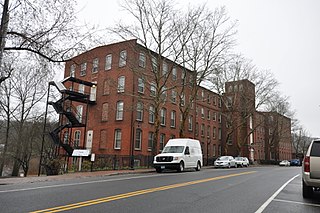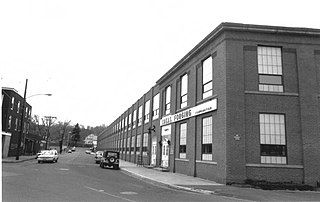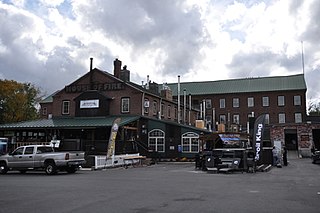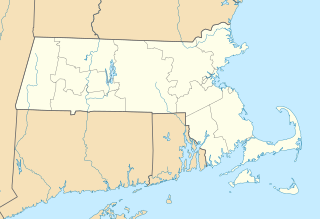
Southington is a town in Hartford County, Connecticut, United States. As of the 2010 United States Census, it had a population of 43,069. Southington contains the villages of Marion, Milldale, and Plantsville.

Plantsville is a neighborhood in the town of Southington, Hartford County, Connecticut. It is centered at the merger between South Main Street and West Main Street. As of the 2000 Census there were 10,387 people living in the Zip Code Tabulation Area for zip code 06479, which is assigned the postal city name Plantsville. The Zip Code Tabulation Area includes the entire southwestern corner of the town of Southington, including Marion and Milldale. Beginning in 2015 Plantsville was listed as a census-designated place.

The Russell Company Upper Mill is an historic structure in Middletown, Connecticut, built in 1836 and listed on the National Register of Historic Places. The building stands at the junction of Russell Street and East Main Street in South Farms. There is a small pond to the south. East Main Street's commercial and industrial development ends there. To the north, small businesses border the street, followed by the buildings of Russell Manufacturing Company, the area's most dominant feature. Russell Street crosses Sumner Brook nearby and ascends to a large residential district to the west. The mill is currently a condo-apartment complex.

The Wilcox, Crittenden Mill, also known as Wilcox, Crittenden Mill Historic District, is a 17-acre (6.9 ha) property in Middletown, Connecticut that was listed on the National Register of Historic Places in 1986. It was the location of the Wilcox, Crittenden company, a marine hardware firm. The historic district listing included four contributing buildings and three other contributing sites.

The Whitney & Company building is a historic industrial facility in Leominster, Massachusetts. The utilitarian brick four story building was built in 1893, and extended in 1923. It was built by Fred Abbot Whitney and Walther F. Whitney, whose business was the manufacture of boxes, notably paper boxes and satin-lined boxes, used for shipping other products to customers. The site was listed on the National Register of Historic Places in 1989. It has since been converted into residences called the Watermill Apartments.

Westfield Whip Manufacturing Company is a historic factory at 360 Elm Street in Westfield, Massachusetts. Built about 1887, it is the best preserved of Westfield's extant whip factory buildings. It is also home to the last surviving business of the many whipmakers that once operated in Westfield. The factory was listed on the National Register of Historic Places in 1985, and included in an expansion of the Westfield Center Historic District in 2013.

The Asa Barns’ Tavern, also known as the Levi B Frost House, is an historic building in the Marion village of Southington, Connecticut. The home represents over two centuries of Southington history. Appearing twice on the National Register of Historic Places, as an individual structure and as a part of the Marion Historic District, the house is significant both architecturally and historically for its connection to United States and New England history.

The Pratt, Read and Company Factory Complex is an historic industrial facility located in Deep River, Connecticut. Established in 1863 and significantly enlarged in 1914, it was one of the principal sites of ivory processing in Connecticut, production combs, buttons, and piano keys. The complex was listed on the National Register of Historic Places on August 30, 1984. It has been converted to residences.

The Quinnipiac Brewery, also known as Brewery Square, is a complex of brick buildings at 19-23 River Street in the Fair Haven neighborhood of New Haven, Connecticut. Developed beginning in 1892 and operative until the 1930s, the complex is a rare example of a late 19th-century large-scale brewery. The complex was listed on the National Register of Historic Places in 1983. Most of the complex is now residences.

The Atwater Manufacturing Company is a historic industrial property at 335 Atwater Street in Southington, Connecticut. The company, founded in 1867 and now known as Rex Forge, has long been one of Southington's major industrial employers. The ten extant buildings of the complex date as far back as 1912, and are an important element of the town's industrial past. The property was listed on the National Register of Historic Places in 1988.

The Cocheco Mills are a historic mill complex in the heart of Dover, New Hampshire. The mills occupy a site at a bend in the Cocheco River that has been the site of industrial activity since at least 1822, when the Dover Cotton Factory was built there. The present mill buildings were built between the 1880s and the early 20th century, and were listed on the National Register of Historic Places in 2014.

The Blakeslee Forging Company is a historic industrial complex at 100 West Main Street in the Plantsville area of Southington, Connecticut. The surviving six buildings, dating to about 1910 or later, were developed for a company founded in 1877 that specialized in drop forging. The buildings are well preserved structures typifying industrial buildings found in Southington from that era. The complex was listed on the National Register of Historic Places in 1988.

The Clark Brothers Factory No. 2, also known as Clark Brothers Bolt Company, is an industrial complex at 409 Canal Street in Southington, Connecticut. Built between 1911 and 1918, the complex is a good example of vernacular industrial architecture of the early 20th century, and was home to one of the community's major industrial employers. The complex was listed on the National Register of Historic Places in 1988.

The Hurwood Company is a historic industrial complex at 379 Summer Street in Southington, Connecticut. Built beginning sometime before 1884, this complex of mainly brick buildings is typical of the town's industrial landscape of the late 19th and early 20th centuries, and was where solid-headed screwdrivers were first manufactured. The complex was listed on the National Register of Historic Places in 1988.

The Peck, Stow & Wilcox Factory was a historic factory complex at 217 Center Street in Southington, Connecticut. Begun in 1870, it was home to the town's largest industrial employer of the late 19th century. Surviving elements of the factory, dating to 1912, were listed on the National Register of Historic Places in 1989. The complex, last used by Ideal Forging, was demolished in 2015 after it was shuttered in 2003.

The Pultz & Walkley Company, also known more recently as The Five Star Company, is a historic industrial complex at 120 West Main Street in the Plantsville village of Southington, Connecticut. Founded in the 1870s, Pultz & Walkley was a major producer of paper bags. The multi-building complex is one of the town's better-preserved industrial properties, and was listed on the National Register of Historic Places in 1988.

The H. D. Smith Company Building is a historic industrial building at 24 West Street in Plantsville, Connecticut. With a construction history dating to 1882, it is one of the more architecturally interesting examples of Southington's industrial architecture, and was home to H. D. Smith & Co. from construction to the 1920s. It was listed on the National Register of Historic Places in 1977.

The Briggs Carriage Company is a historic industrial complex at 14 and 20 Cedar Street in Amesbury, Massachusetts. Built before 1890, these two buildings are a surviving reminder of the city's late 19th century prominence as a major carriage manufacturing center. They were listed on the National Register of Historic Places in 2007.

The Matthews and Willard Factory was a historic industrial site at Cherry Avenue and North Elm Street in Waterbury, Connecticut. Founded in 1874, Matthews and Willard contributed to the expansion of Waterbury's brass processing industry. The plant remained little altered from its last period of expansion c. 1900, and was a good example of period industrial architecture. It was listed on the National Register of Historic Places in 1988, and was demolished in 2012. As of 2018, the site stands vacant.

The Watson, Newell & Company Factory is a historic industrial complex at 67 Mechanic Street in Attleboro, Massachusetts. Built between 1889 and 1947, it is located on the site of the city's first textile mill, and was home to a prominent jewelry manufacturer for many years. It was listed on the National Register of Historic Places in 2020.






















